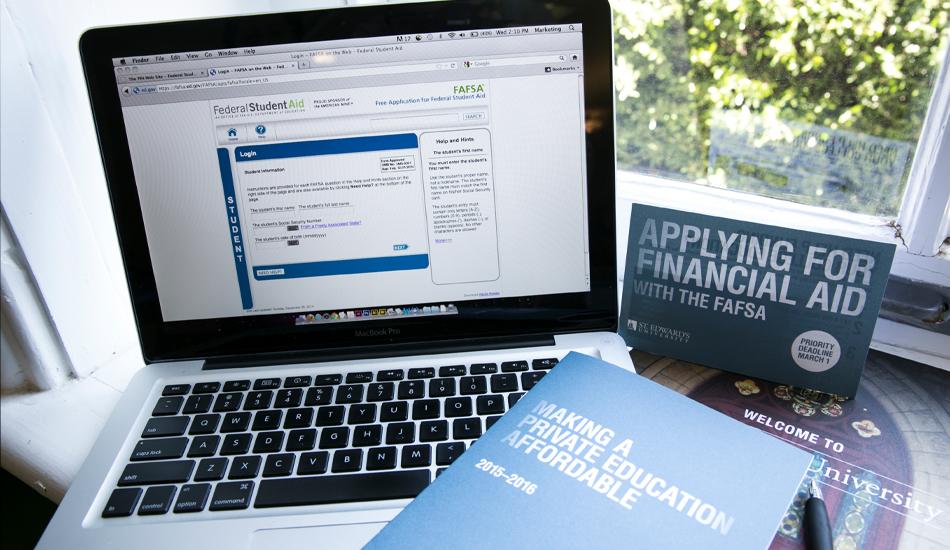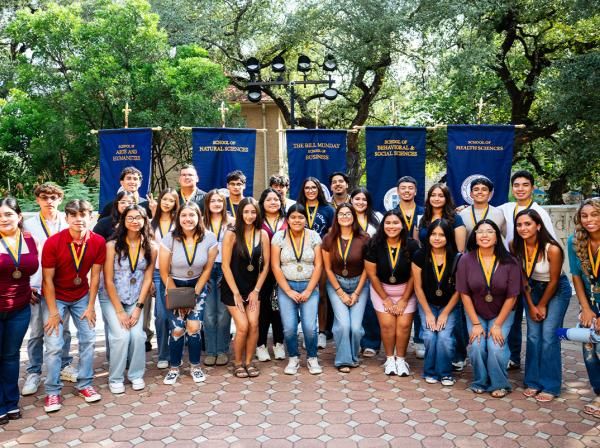Funding Your Graduate Education
As you consider investing in your future with a master’s degree, covering the cost of graduate school is a big part of your decision.
Don’t hesitate to apply for a program at St. Edward’s because you think it’s too expensive. Our Student Financial Services advisors can help you navigate funding resources and make a plan. Here are 9 things to know and do as you explore your options.

1. Create a Financing Strategy
Most graduate students at St. Edward’s fund their education with a combination of loans, savings and income. If you decide to take out a loan, begin by developing a budget. To help you plan, your Student Financial Services advisor can give you a breakdown of your program’s anticipated costs. Borrow only what you need to cover your education expenses. And make sure you fully understand the terms and conditions of the loan.
2. Look at Federal Loans First
These low-interest, fixed-rate loans generally offer better terms and rates than private loans and should be your first choice for aid. The following are available to graduate students (U.S. citizens or eligible noncitizens) who meet federal eligibility criteria.
Direct Unsubsidized (Stafford) Loan
Provides up to $20,500 per year with a maximum lifetime amount of $138,500, including what you may have borrowed for undergraduate college expenses, and does not require a credit check.
Direct Graduate PLUS Loan
Provides up to the total cost of attendance, minus any other student financial aid you receive, and requires a credit check or a co-signer.
3. Submit the FAFSA — the Sooner the Better
Federal loans require that you submit the Free Application for Federal Student Aid annually to determine your eligibility. After your FAFSA is successfully processed, the Department of Education will send the results to you and St. Edward’s within two to four days. Once you’ve been accepted to St. Edward’s and we’ve received your FAFSA results, you’ll receive a financial-aid award notice from us within a few days.
4. Know How Your Federal Loan Is Allocated
Federal loan borrowing limits reset each summer, and the amount is split evenly between the semesters (summer, fall, spring) you attend each academic year. If you begin your program in fall, your annual loan amount will be split in half the first year. If you start in summer, it will be split in thirds.
5. Stay in Good Standing for Your Loan
To remain eligible for your federal loan, you must maintain a minimum GPA of 3.0, successfully complete 75% of your courses each academic year, and take at least 4.5 credit hours each semester. If you drop below 4.5 hours, you’ll have to begin payments on the loan.
6. Be Clear about Loan Repayment Terms
Repayment of federal loans is deferred while you’re enrolled in your program at least half-time and begins six months after graduation. It’s important to realize that the interest on federal loans for graduate students is not subsidized; interest accrues from the day the loan is disbursed until fully repaid.
7. Check Out Other Sources of Funding
Here are additional financing options to consider:
Private Education Loans
Private loans available through banks, credits unions and other financial institutions are another option. They require a credit check or cosigner and often have higher interest rates and less flexible payback terms than federal loans. If you choose to go his route, St. Edward’s can supply a list of recommended loan providers to pursue.
Scholarships and Grants
Though St. Edward’s does not offer scholarships, grants or work-study programs for graduate students, outside scholarships and grants may be available through other groups, such as foundations, businesses and community or religious organizations. Our financial services advisors can provide you with a list of scholarship and grant resources for your specific degree program.
Employer Tuition Benefits
If your master’s degree will enhance the skills you bring to your job, it’s worth checking with your employer about providing tuition assistance to cover all or a portion of your tuition. You can receive up to $5,250 in tax-free employer education assistance each year.
Assistance Programs for Veterans
If you are a veteran of the U.S. Armed Forces, you may be eligible to use your VA Educational Benefits at St. Edward’s. Our Veteran Affairs office can help determine your eligibility and answer any questions you have.
8. Take Advantage of Tax Benefits for Education
Educational tax deductions can help offset the costs of your degree by reducing your income tax. Don’t overlook them! For example, you can take a tax deduction for the interest paid on your student loans, up to $2,500 a year. And the government’s Lifetime Learning Credit allows you to claim up to $2,000 per year for tuition and fees, books, supplies, equipment, and mileage required for school.
9. Be Aware of How Tuition Is Paid
Your tuitions payments at St. Edward’s can be made in one lump sum at the beginning of each semester or in four monthly installments throughout the semester. Loan, scholarship and veteran assistance money is sent directly to the university to pay tuition and fees. Whatever is left over is reimbursed to you for remaining expenses. If you receive employer tuition assistance, you can arrange to be reimbursed by your employer for the amount they agree to pay, or St. Edward’s can bill your employer for that amount at the start of each semester.
Questions? We can help!
Meet with a St. Edward’s financial services advisor who will work with you throughout your graduate education. Email us or call 512-448-8523.
Calculating the Cost
Deciphering the real cost of college can be complicated, but it doesn't have to be. It starts by understanding what you'll pay after you're awarded scholarships and grants.
Join the thousands of others who have tried our Net Price Calculator — 5 minutes is all it takes to estimate what you'll pay.
Hint: Make sure you have School Rank, GPA and Current Tax Information available before you start!


